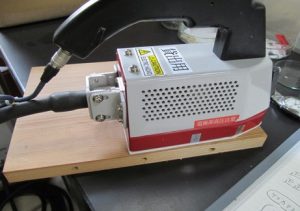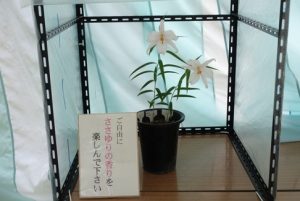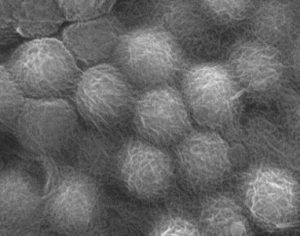2018 Activity Report for Mission 4: Development and Utilization of Wood-based Sustainable Materials in Harmony with the Human Living Environment
Updated: 2019/04/25
Award
The Japan Wood Research Society Best Paper Award
【Winner】Sung Wook HWANG, Kayoko KOBAYASHI, Shengcheng ZHAI, Junji SUGIYAMA
【Title】Automated identification of Lauraceae by scale-invariant feature transform
【Awarding Journal】journal of Wood Science volume 64
Research 1: Innovation of timber structure
Principal Investigator (PI): Hiroshi Isoda (RISH, Kyoto University)
Research collaborator(s): Takafumi Nakagawa (RISH, Kyoto University), Akihisa Kitamori (RISH, Kyoto University), Takuro Mori (Hiroshima University), Yasuhiro Araki (National Institute for Land and Infrastructure Management)
Based on the research for mechanical characteristics of new wooden materials such as cross laminated timber (CLT), we will develop new timber joints and construction system, and evaluate its structural performance which will contribute to the establishment of a sustainable society. We will also promote research on the composite structural members and buildings that combine wooden materials and wooden structures with other materials and structures in order to propose new developments in the use of wood.
・Study on earthquake resistance performance of CLT buildings in terms of structural member, mechanical joint and material properties.Development of hybrid floor system as timber-concrete composite structural member.
・Study on seismic reinforcement method using CLT shear panel infilled in steel frame.
Publications, etc.
- 金澤和寿美:京都大学大学院農学研究科修士論文:「CLTを耐震壁に用いた鉄骨造の構造性能」 (in Japanese)
- ドットコーポレーション、京都大学生存圏研究所、CLT等新たな木質建築部材利用促進・定着委託事業のうち国による開発「鉄骨フレームとCLT壁を組み合わせた架構の構造と耐火の標準納まりと設計法の開発」報告書、平成31年3月 (in Japanese)
Research 2: Quantitative morphology of woody plants
Principal Investigator (PI): Junji Sugiyama (RISH, Kyoto University)
Research collaborator(s): Kayoko Kobayashi (Tokyo University), Hiroaki Kawashima (Kyoto University), Nakajima Takeshi, Yusuke Kita Suyako Tazuru, Tomoya Imai(RISH, Kyoto University), Yoshiyuki Torigoe (Nara National Museum), Imazu Setsuo (Nara University)
Promotion of research related to the wood collection maintained at the RISH Xylarium, with particular attention to a scientific analysis of the information engraved inside wood, and with the expectation that the knowledge obtained would provide the future direction of wood utilization toward a sustainable society.
1.Automated wood identification by machine learning combined with image analysis.
2.Wood identification by nondestructive methods.
Publications, etc.
- Junji Sugiyama, Kayoko Kobayashi:Toward wood identification by AI, In The Secrets of Ashura statue(Editorial Supervision by Kofukuji Temple) , Asahi Shinbun Shuppan、2018 (in Japanese)
- Junji Sugiyama、Ashura statue: strategy for wood identification、417th Kofukuji Cultural Seminar Textbook (in Japanese)
- Kayoko Kobayashi, Sung-Wook Hwang, Takayuki Okochi, Won-Hee Lee, Junji Sugiyama, Non-destructive method for wood identification using conventional X-ray computed tomography data, Journal of Cultural Heritage, https://doi.org/10.1016/j.culher.2019.02.001.
Research 3: From Production to Recycling of Wood Biomass-Based Materials
Principal Investigator (PI): Kozo Kanayama (RISH, Kyoto University)
Research collaborator(s): Kenji Umemura, Soichi Tanaka (RISH, Kyoto University)
The effective usage of wood is required to produce and reuse the eco-friendly materials. Impregnation of wood with chemical liquids is one of the key techniques. This technique has been used to control the biodegradation and combustion. After the impregnation process, however, there often exist some areas in cell walls without being treated with chemicals, leading to the inadequate control. Our study has been focused on the diffusion of chemicals into cell walls in the conditioning process of liquid impregnated wood. In this process, the liquid is known to flow in the cell cavities, leading to the inadequate treatment because of the lack of the liquid in the cell cavities. The mechanism of the liquid flow however, has not yet been studied. The purpose of this study is to investigate the liquid flow in the cell cavities during the conditioning of the impregnated wood. To understand the liquid flow mechanism, we performed the model experiment using the plastic capillaries with inner diameter and the length of 0.5 mm and 90 mm.
The capillary, one side of which was sealed, was impregnated with aqueous solution of dye, and subsequently conditioned at several levels of temperature and relative humidity. The solution (liquid phase in Fig.3-1) flew in the capillary during the water evaporation to disappear. The flow was confirmed to affect the temperature and relative humidity.

Fig. 3-1 Schematic diagrams for capillary imitating wood cell in impregnated wood under conditioning
Publication
- Nagai: Master’s thesis in graduate school of agriculture, Kyoto University: A fundamental study on pretreatment for wood flow forming- Temporal variation of solution distribution in impregnated wood during conditioning-.
Research 4: Establishment of environmentally harmonized innovative recycling system of resources in the humanosphere
Principal Investigator (PI): Tsuyoshi Yoshimura (RISH, Kyoto University)
Research collaborator(s): Toshimitsu Hata, Aya Yanagawa (RISH, Kyoto University)
Our research targets are a) to enhance the durability of wood-based materials based on fundamental researches, and b) to research and develop sustainable functional materials from wood. The present research topics are as follows:
1.Ecology, physiology, and management of wood-deteriorating organisms
The mass cultures of the wood-attacking beetles, Nicobium hirtum and Heterobostrychus aequalis, were developed, and their feeding ecology were investigated. In addition, the high-frequency treatment was successfully applied to kill their larvae.
2.Sustainable functional materials from wood.
Activated carbon was prepared from phenolic resin and carbonized wood in order to improve the CO2 adsorption amount. The influence of production conditions of activated carbon on the micropore structure was investigated using CO2 adsorption measurement and transmission electron microscope.
3.Study of insects, plants and microbe for creating sustainable humano-habitability
Saikusa Festival for protection against diseases and disaster is held by Isagawa Shrine. Flowers of the Japanese bamboo lily Lilium japonicum are symbolic sacred flower for this festival. We found that the scent of the flower has relaxation effects.
Publications,etc.
- Ikhsan Guswenrivo, Hiroki Sato, Izumi Fujimoto and Tsuyoshi Yoshimura: First record of the termite ectoparasite Laboulbeniopsis tarmitarius Taxter in Japan, Mycosecience, 59, 247-251, 2018, DOI: 10.1016/j.myc.2018.01.00
- Lee-Jin Bong, Kok-Boon Neoh and Tsuyoshi Yoshimura: Comparison of Water Relation in Two Powderpost Beetles Relative to Body Size and Ontogenetic and Behavioral Traits, Environ. Enotomol., 2018, 1-7, DOI: 10.1093/ee/nvy062
- Yoshiyuki Yanase, Takuro Mori, Emiria Chrysanti、Tsuyoshi Yoshimura, Wakako Ohmura, Shuji Itakura and Yoshihisa Fujii: Nondesructive detection of attack by the termite Incisitermes minor (Hagen) using acoustic emission and microwave methods, Jpn. J. Environ. Entomol. Zool., 29(2)、41-47, 2018, DOI: https://doi.org/10.11257/jjeez.29.41 (in Japanese)
- Hasan Ashari Oramahi, Tsuyoshi Yoshimura, Farah Diba, Dina Setyawati and Nurhaida: Antifungal and antitermitic activities of wood vinegars from oil palm trunk, J. Wood Sci., 64, 311-317, 2018, DOI:10.1007/s10086-018-1703-2
- Lee-Jin Bong, Kok-Boon Neoh and Tsuyoshi Yoshimura: Deevelopmental irregularity and abnormal elytra formation in the oriental wood borer by physical disturbance, J. Insect Sci., 18(1), 12, 1-6, 2018, DOI: 10.1093/jisesa/iey001
- Mizuki Fujisawa et al.:A Questionnaire-based Investigation Indicated Mental Relaxation Effects in the Scent of the Sacred Flower of the Saikusa Festival, Lilium japonicum, Japanese Journal of Phamacognosy 73(2), 1-6. (in Japanese)
Research 5: Production and utilization of cellulose nanofibers
Principal Investigator (PI): Hiroyuki Yano (RISH, Kyoto University)
Research collaborator(s): Kentaro Abe (RISH, Kyoto University)
Cellulose nanofibers (CNFs) are a fundamental component of plant cell walls. Because of their excellent mechanical properties and their high specific surface area, we are studying the utilization of CNFs as a reinforcing filler of resin composites.
In this work, we mixed cellulose nanofibers (CNFs) water slurry and acrylic resin emulsion with different droplets size (55, 130 and 527 nm diameter). After vacuum-filtering the water slurry, CNFs and acrylic resin droplet mixture mats were vacuum-dried to obtain CNFs reinforced acrylic resin film (200-300μm) with a fiber content of 0% to 5wt% and were subjected to the evaluation of mechanical properties and dynamic visco-elastic properties.
As shown is Fig.5-1, the surface of acrylic resin droplets was covered by CNFs uniformly. It was demonstrated that Young’s modulus of the composite increased with increase of droplets size.
Publications, etc.
- Igarashi Y, Sato A, Okumura H, Nakatsubo F, Yano H, Manufacturing process centered on dry-pulp direct kneading method opens a door for commercialization of cellulose nanofiber reinforced composites, Chemical Engineering Journal, 563-568, 2018
- Abe K, Morita M, Yano H, Fabrication of optically transparent cotton fiber composite, Journal of Materials Science, 53 (15), 10872-10878, 2018/08
- Yano H, Omura H, Honma Y, Okumura H, Sano H, Nakatsubo F, Designing cellulose nanofiber surface for high density polyethylene reinforcement, Cellulose, 25 (6), 3351-3362, 2018
- Wang L, Okada K, Sodenaga M, Hikima Y, Ohshima M, Sekiguchi T, Yano H, Effect of surface modification on the dispersion, rheological behavior, crystallization kinetics, and foaming ability of polypropylene/cellulose nanofiber nanocomposites, Composites Science and Technology, 168 (10), 412-419, 2018






